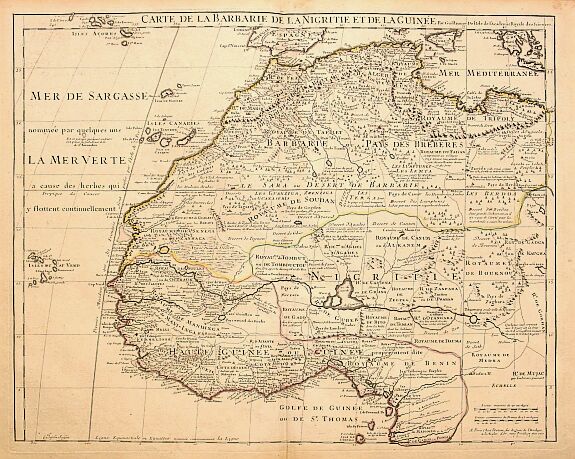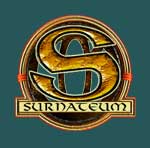|
|
 Inv.
SRS/BN/prd-50942 Inv.
SRS/BN/prd-50942
Map of Barbary, Nigritia and Guinea
Published in Paris in 1707 by Guillaume de l'Isle. This edition is
taken from the Atlas Nouveau (1730) in Amsterdam,
Jean Covens and Corneille Mortier Geographers
Discovered in the Surnateum Archives
Description:
 Map
of northwest Africa by celebrated French geographer Guillaume de l'Isle (1675-1726),
the father of modern cartography and a member of the French
Royal Academy of Sciences. This highly detailed map, annotated in a
somewhat amusing manner (at least when read from a contemporary
perspective), was engraved by Inselin and describes the Niger river as
an offshoot of the Nile. Map
of northwest Africa by celebrated French geographer Guillaume de l'Isle (1675-1726),
the father of modern cartography and a member of the French
Royal Academy of Sciences. This highly detailed map, annotated in a
somewhat amusing manner (at least when read from a contemporary
perspective), was engraved by Inselin and describes the Niger river as
an offshoot of the Nile.
The Sargasso Sea is located just off the coast of Africa.
An enormous lake joins Senegal and Niger, and so it goes on.
Some of the more delightful annotations are worth a quick detour:
- "Kingdom of Temian, the inhabitants of which are what are
referred to as Anthropophagi."
- "The Calbongos Peoples, mean-spirited and deceitful, and the
enemy of their neighbours, the other Calbongos."
- "Desert of Berdoa, a great Dry Place, where there is no
Safety for merchants due to the bandits."
- "This area is said by some to be the location of the fabulous
island of St Borondon."
A description of the Canary Islands is accompanied by a description
of the island of San Borondon, the mythical isle discovered by Saint Brendan
(or Brandan ), the great Celtic navigator, at the end of his celebrated
travels to the Fortune Islands. The island of San Borondon was paradise
on earth.
Please note that Prospero's island would be found in the upper
right-hand part of the chart.
Note:
Saint Brendan (ca 486-550), an Irish monk and a priest in Clonfert,
undertook a series of maritime adventures in the first half of the 6th
century that took him to Greenland, Iceland and probably the Americas (well
before Columbus) in search of paradise on earth.
The description of an island discovered by the priest and on which he
celebrated mass before it disappeared under the waves is sometimes
confused with the final stage of this sailor's journey. An island
cloaked in fog and on which an angel revealed to him the face of god
before thwarting his attempts - for the soul alone may enter heaven
after the body has disappeared.
Over the following centuries, especially during the 18th century,
hundreds of witnesses claimed to have seen the eighth Canary
Island - now known as the Ghost Island.
Following the acquisition of this map and numerous discussions amongst the staff of
the Surnateum in 1938, an expedition set out to find these
islands.
The explorers were not necessarily looking for heaven on earth, but
they did assume that the island would be a gateway to Atlantis - or the
remnants of Atlantis. According to one theory, the Canary Islands were
the visible part of that lost continent, as described in Plato's Timaeus.
This did not necessarily contradict the theories expounded by Ignatius Donnelly (1831-1901),
an American who, in 1882, published his work entitled Atlantis, the Antediluvian World.
Recent work by German archaeologist Leo Frobenius
also moved in this direction (Mythology of Atlantis).
A discussion with Professor Auguste Piccard on the possibility of
building a device allowing man to explore the ocean depths has convinced
our archaeologists of the value of promoting research in this area. Some
sensitives had expressed the hypothesis - typical of that time -
that they were descendants of the people of Atlantis. They were trying -
and indeed they still are trying - to find a reason to explain their
curious gifts.
The Collector did not share this opinion and so advised against the trip.
Certain Nazis also
thought they were descended from the people of Atlantis, and the
Collector had no time for their regime. Moreover, the Collector was more
interested in returning hauntiques to their rightful place, not removing them from their natural environment or
sanctuaries. Too many unscrupulous individuals had already committed
irreparable acts of sacrilege.
Despite his pleas for restraint, a small group set off for the Canary
Islands on a voyage of discovery.
As they have never been heard of since, we can only suppose that they
found the island - or that their ship went down with all hands.
|







 Map
of northwest Africa by celebrated French geographer Guillaume de l'Isle (1675-1726),
the father of modern cartography and a member of the French
Royal Academy of Sciences. This highly detailed map, annotated in a
somewhat amusing manner (at least when read from a contemporary
perspective), was engraved by Inselin and describes the Niger river as
an offshoot of the Nile.
Map
of northwest Africa by celebrated French geographer Guillaume de l'Isle (1675-1726),
the father of modern cartography and a member of the French
Royal Academy of Sciences. This highly detailed map, annotated in a
somewhat amusing manner (at least when read from a contemporary
perspective), was engraved by Inselin and describes the Niger river as
an offshoot of the Nile.